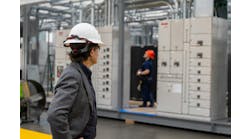NTT Data, Schneider Electric Collaboration Anticipates More Modular Data Centers for AI Edge Computing
Amid external requests for informed commentary on the subject, and based on the flood of recent news in wake of current industry mega-trends, there's been growing empirical conviction at the DCF editorial desk that -- given the way the growth in digital infrastructure is going as fueled by the AI boom (colossally) -- the role of edge data centers and micro data centers is, ironically enough, set to become front and central.
Taking it back to basics, as very aptly characterized by data center monitoring specialist Sunbird DCIM, "Edge data centers are smaller facilities located close to the populations they serve that deliver cloud computing resources and cached content to end users. They typically connect to a larger central data center or multiple data centers."
In the emerging world of AI, ML and IoT, the low latency and locational advantages of edge and remote computing most likely become not just nice-to-have, but must-have propositions. The list of edge use cases as recited by Sunbird in its aformentioned handy, evergreen explainer, What is an Edge Data Center? reads like proof of this contention: autonomous applicatons, smart cities, manufacturing, financial institutions, telemedicine, augmented reality, AI virtual assistants, video monitoring, gaming, content delivery...
And the list will no doubt go on to include more and probably even undreamt applications, all traveling at the speed of light to and from the nearest data center (as we like to tell the kids); but of course, as trenchantly noted by Jeff Goldblum as the hot-shot scientist in the movie Jurassic Park, it all "must go faster." Cue then an incipient revolution in modular edge and micro data center facilities.
Take It From Tony Grayson
We know that the term "revolution" is not to be thrown around lightly. But in an insightful recent LinkedIn post entitled, "Embracing the Micro Data Center Revolution," the noted data center industry influencer and distinguished business and technology leader Tony Grayson, who presently serves as Veteran's Chair at Infrastructure Masons and Compass Datacenters' GM in Seattle, contends that "the shift towards micro data centers (DCs) is beginning to happen."
Grayson opines that adopting micro DCs offers a compelling proposition that offers more than just scalability, but critical flexibility and responsiveness to the changing demands of the digital world. "When it's time for an upgrade or expansion, deploying a new set of micro DCs can be more straightforward and potentially more cost-effective than retrofitting an outdated infrastructure," he writes.
Grayson's post continues:
"The pace of change in our industry is staggering, rendering traditional long-term planning less effective. As we look ahead, it's becoming increasingly clear that building for the 'what ifs' of 3-5 years down the line is a gamble many are missing the mark on.
Why? Because demand for compute is skyrocketing, and the longevity of servers is on the rise ... In this environment, it makes pragmatic sense to tailor data centers to specific deployments with just a little wiggle room for expansion. This strategy acknowledges that future needs will require new data centers to meet them head-on.
Think of micro DCs as consumable equipment, akin to the servers they house. They have a usable lifespan. By the time a server reaches the end of its life, the technological and operational requirements will have evolved to the point where a new facility design becomes not just a necessity but an opportunity for innovation."
NTT, Schneider Electric Pact Meets Impetus for Edge, Micro Data Centers
In the end, the news cycle is usually a reliable guide. Here at Data Center Frontier, we've recently noted how new data center industry partnerships and M&A are facilitating operators' uptake of liquid cooling technologies as a linchpin for AI computing. Now, the same dynamic appears to be in effect in the area of modular edge data centers.
To wit, in newly announced move "to drive AI innovation at the edge," NTT Data and Schneider Electric are now furthering their work together to deliver an integrated technology platform combining edge, Private 5G, IoT and modular data centers, for purposes of "enabling edge connectivity anywhere."
In jointly delivering the infrastructure to support demand for AI applications at the edge, the companies are working with Marienpark Berlin in Germany to enable "a connected experience" across this historic landmark site, supporting the computational demands of edge-located generative AI uses.
The new solution combines NTT Data’s Edge as a Service offering, which manages edge-to-cloud, Private 5G, and IoT capabilities, with Schneider Electric’s EcoStruxure line, a modular data center platform that fuses OT controls with the latest in IT technologies.
The partners say the joint platform enables companies to maximize energy efficiency in meeting the demands of compute-intensive tasks such as machine vision, predictive maintenance, and other AI inferencing applications at the edge.
“We've listened to our customers and know that processing vast amounts of data generated by edge devices is where the future of digital transformation lies,” said Shahid Ahmed, EVP New Ventures and Innovation at NTT Ltd. "That's why we're excited to announce that we have the solution to meet these obstacles and are ready to lead the way towards a more connected and efficient digital world. We are thrilled at the prospect of what our continued collaboration with Schneider Electric means for the industrial and other sectors."
According to NTT DATA’s Edge Advantage report, nearly 70% of enterprises are accelerating edge adoption to solve critical business challenges. Via the new platform offering, the partners say that customers can now implement a complete solution -- including edge data centers tailored for digital transformation in remote and brownfield locations, where high compute demands critical infrastructure such as power, cooling, racks, and specialized IoT and AI management systems.
Further, the companies said they will now go to market to address joint customer requirements to meet growing demand from organizations who are looking to leverage edge compute to support automation and enable data-driven decision making.
From MWC Barcelona to Marienpark Berlin
To christen the new collaboration, NTT DATA and Schneider Electric announced at this week's Mobile World Congress (MWC Barcelona 2024) that they'll be delivering the first Private 5G -enabled deployment of an EcoStruxure data center at Marienpark Berlin. A historic site that is being developed into an innovation park, the park's area spans over 30-hectare, equivalent to 74 acres. The deployment will focus on delivering enhanced connectivity and compute experiences for users campus-wide.
Guido Schütte, Managing Director, Marienpark Berlin, said, “Today’s innovation ecosystems in Marienpark increasingly depend on specific technological infrastructures. Easy-to-access computational power combined with advanced connectivity are a key issue. We need an innovative environment with such an infrastructure to satisfy future user demands of our community."
As noted by NTT Data and Schneider Electric, the companies initially "co-innovated" to test the power of Private 5G technology at Schneider Electric’s Lexington Smart Factory, the first of that company's U.S. plants to become a smart factory showcase site, leveraging a blend of Private 5G, IoT connectivity, edge analytics, and predictive analytics technologies to drive energy efficiency and advance sustainability goals.
Rob McKernan, President, Cloud & Service Provider Segment at Schneider Electric remarked:
“After leveraging NTT Data’s expertise in Private 5G connectivity and then maximizing synergies with our EcoStruxure architecture in our facilities, it’s time to expand our collaboration and bring a complete solution to industrial customers. Together, we aim to assist global clients in adopting connected devices, specialized industrial solutions, and the right edge computing infrastructure with modular data centers to gain valuable data insights, particularly in the context of IoT and emerging AI requirements.”
The companies contend the new collaboration ultimately addresses the challenges brought on by Industry 4.0 applications, ensuring seamless connectivity, high bandwidth, and secure low latency connections through edge data centers. As quoted in a press release, Camille Mendler, Chief Analyst, Enterprise Services, for industry researcher Omdia observed:
“Industry 4.0 relies on actionable, data-driven intelligence delivered in real time whether that be in a factory, an industrial park, an airport, or an office campus. AI-enriched data already accounts for a third of enterprise network traffic, but it will dominate digital interactions by 2030. To profit from AI insights, enterprises must invest in digital resources at the edge, and the technology infrastructure that powers it -- now.”
The new collaboration with NTT builds on the edifice of a trend exemplified last fall with Schneider Electric, JLL and Lumen's announcement of plans to proliferate modular data centers across the U.S. to meet demand for digital infrastructure.

Matt Vincent
A B2B technology journalist and editor with more than two decades of experience, Matt Vincent is Editor in Chief of Data Center Frontier.





